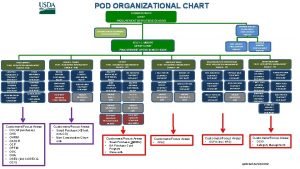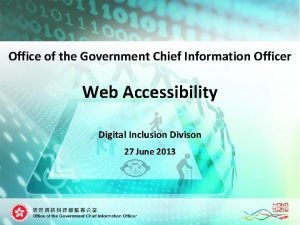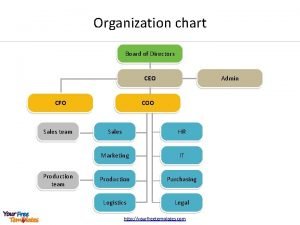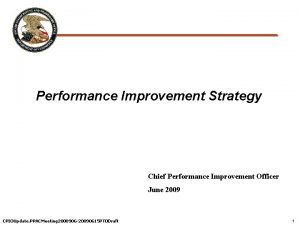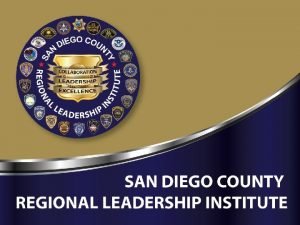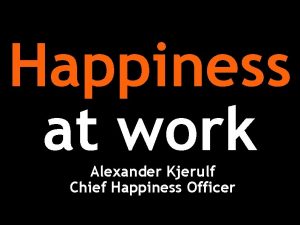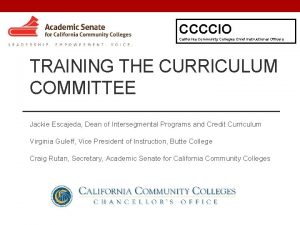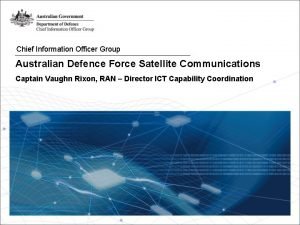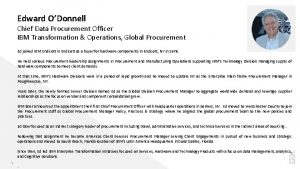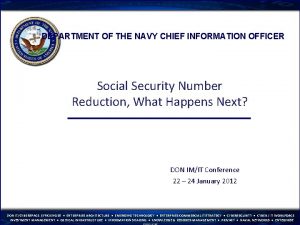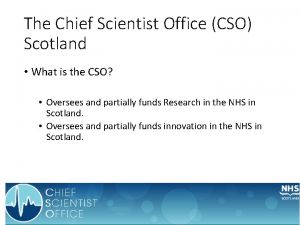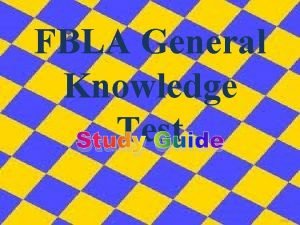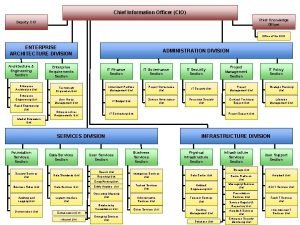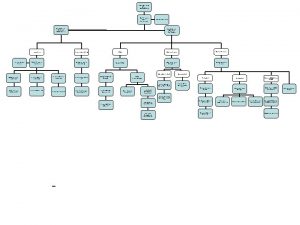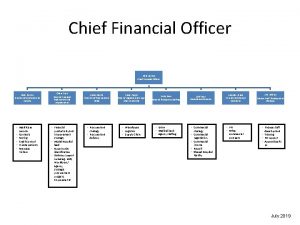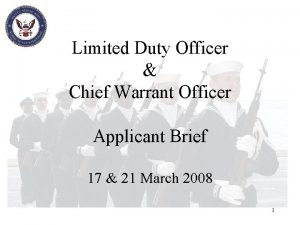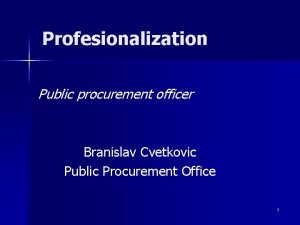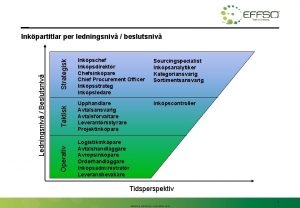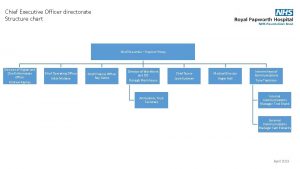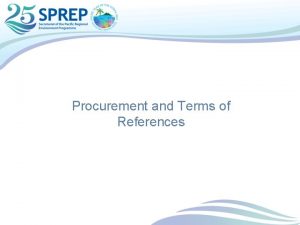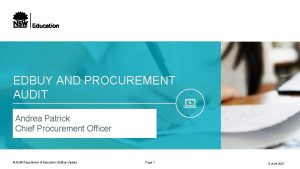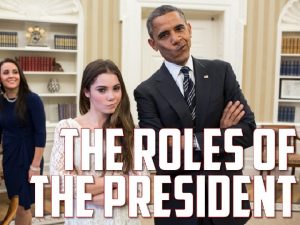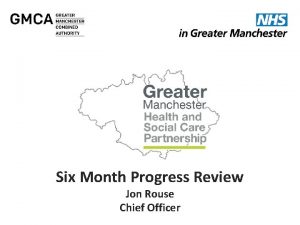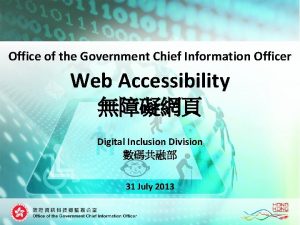Office of the Chief Procurement Officer Progress New






















- Slides: 22

Office of the Chief Procurement Officer Progress & New Projects Office of the Chief Procurement Officer: 13 April 2016 1

Status of OCPO • Office established in March 2013, – 2015 SCM Review released: diagnostic of public procurement and provides a reform roadmap • OCPO corporate structure: – Policy & Legal – Governance, Monitoring & Compliance, – Transversal Contracts, – Strategic Sourcing, – SCM ICT, and – SCM Stakeholders &Clients Management • Office is fully established – Supported by technical expertise – SCM is a specialised field 2

Achievements: Stakeholder management • The launch of the CSD and other systems on 1 September 2015, kickstarted the road shows to all nine (9) provinces • Training was provided on the CSD/e. Tenders for users • Engagements on other forthcoming reforms were shared • A 3 -month radio (9 African Languages & 2 Commercial) Newspaper & Billboards campaign was run for the CSD registration and access to e. Tenders • The latest workshops with SCM practitioners occurred every Thursday for the last 4 weeks • Engagements with Civil Society Organisations on how they can improve/assist government on oversight – further Training will be provided • Interactions with different business groupings like BMF, BBC, CESA etc 3

Achievements: Automation • Central supplier database – Central portal for registration of prospective government suppliers – Benefits • Once off supplier registration • Reduction of administrative cost/compliance burden • Standardised and electronic verification of supplier information – Tax (SARS) – Business registration (CIPC) – Bank accounts – Identity (DHA) – Tender defaulters, – State employees, etc – 68 000 registered suppliers and counting 4

Achievements: Automation • e. Tender Portal – A web based platform for organs of state to – advertise bids, publish bid notice, amendments or erratums – cancellation and awards – Benefits • Free access to tender documents • Transparency – Advertisements linked to Demand plan – Tender awards, cancellations and amendments • Cost saving – advertisements • 2758 tenders published thus far 5

Achievements: Automation • g. Commerce – Online shopping tool that makes it easier for procurement officials to purchase from transversal contracts, eg. Amazon. com for government. – How does it change the way of doing business-benefits – Benefits • Web based accessible anywhere • Reduced administrative burden • No more calling and placing manual orders • Ability to view products, prices and stock before placing orders • Faster turnaround times • Caps over expenditure-Integration capability with financial systems • Accurate identification of commodities/items – using UNSPSC 6

Achievements: Automation • e. Procurement for government – An integrated procurement system that enables end to end procurement process management – Benefits • Demand management(procurement plans, spend analysis, etc) • Sourcing • Purchasing • Supplier management 7

Achievements: Governance monitoring and compliance • Reviewing contracts above R 10 million – Coal contracts – Eskom – Consulting Contracts – Transnet – Implementing remedial actions of Public Protector: PRASA • Published on the OCPO website on a quarterly basis. • Institutions to submit quarterly reports to provincial legislature and Parliament for oversight purposes. • Oversight committees to assess if institutions comply with procurement plans to speed up service delivery. 8

Achievements: Transversal contracting • • • Spend under central management of R 26 Billion excluding voluntary participation by Municipalities and SOE’s. Currently, the National Treasury manages 40 transversal contracts for the purchase of goods such as vehicles, medical consumables and devices, textiles, etc. Introduction of 4 new commodity spend streams – Property and Leasing – Professional Services – Education – ICT Learner teacher support materials – Savings – reduction in price of stationery packs to R 110 per learner. LTSM Savings projected at R 1 Billion if all provinces participate in the contract. School furniture tender Norms and standards in school construction – R 35 million per school 9

Current Reforms Transversal Contracting : – From 1 April 2016, the participation of government on the existing (40) and new transversal contracts is mandatory. This means all common goods purchased by government will be procured collectively with better buying power. – 15 more contracts will be negotiated and managed centrally which will focus on the health, education property, ICT, support services sectors – Identification, co-ordination and increase in provincially managed contracts – Increased participation of municipalities and SOE’s in centrally negotiated contracts – Increased contracting with local, black and small businesses – Online bidding process for all advertised Transversal Contracts as well as online catalogue for ease of use by buyers and end users 10

Achievements: Strategic Procurement – Strategic procurement framework drafted and circulated. This will provide guidance on how to apply differentiated procurement methods for the various procurements eg. infrastructure vs stationery – Data Analysis conducted on 2012 -2014 spend for National and Provincial Departments, 8 Metros and 12 Public Entities to determine high spend cross cutting commodities – Travel and Accommodation • Direct negotiations with full service carriers – SAA and BA – between 2530% upfront discount achieved • Direct negotiation with 4 major hotel groups – maximum allowable rate per star grading set • National travel policy developed to create uniformity in travel management effective 1 July 2016 – Standards for infrastructure procurement and delivery system developed and issued – School cost model developed and issued 11

Current Reforms Strategic Procurement: – SPF to be issued as Treasury instruction note during the 2016/17 financial year – Communications – Savings of approx. R 300 to R 600 Million • Mobile communications tender issued for National and Provincial requirements and closed April 2016. Evaluation underway. • Fixed Line request for proposal currently being drafted – Further travel and accommodation commodities for negotiation include car rentals, shuttle services, conferencing, bus and coach hire – Medical equipment tender closed April 2016 – serves to standardise equipment utilised by hospitals and clinics – includes high value and volume items which is estimated at approx. R 2 Billion – New projects includes the following projects: • LTSM procurement and distribution model • Medical equipment continuation • Medical Waste Management • Hospital laundry and linen • Pharmaceutical dispensing model • Hospital food services and cleaning services • Infrastructure and related professional services – Co-ordination and increase in sector and department strategic sourcing opportunities eg. ICT 12

Plans for compliance and reporting • Institutions should expected to submit the following to Legislatures and Parliament for oversight: – Reports on the adherence to procurement plans, – Number of deviations from Procurement Plans, – Number of condonations approved by Accounting Authorities contravening the PFMA and SCM Prescripts, – Reports on the outcome of investigations, – Implementation progress on the remedial actions resulting from investigations, – Lack of analysis in what is being bought against the budget, – How is the procurement done on commodities/services not reflected on the procurement plan? 13

Plan for savings of R 75 Billion by year 3 of MTEF • OCPO strategy to savings are focused on five areas: – Renegotiate existing contracts of top 100 suppliers; – Consolidate spent on common goods where economies of scale in provide opportunities for government to use its bulk purchasing power (transversal contracts); – Utilise technology smarter to reduce duplication of effort and cost; – Optimisation and innovation – cost avoidance, cost reduction, cost effectiveness; – Reduction of Red Tape • Efforts by OCPO will result in R 75 billion over the 2016 -2018 MTEF with savings of R 15 billion, R 25 billion and R 35 billion from 2016/17, 2017/18 and 2018/19 financial years respectively 14

Plan for savings of R 75 Billion by year 3 of MTEF • Identify Top 100 suppliers – TELKOM - Basil Read - Aspen Health - Vodacom – Travel with Flair - AG Solutions - MTN - Bio. Vac – Group 5 - Eduvision - Micro. Soft - IBM • Focus on sectors - Negotiation strategy is to focus on industry specific contracts and focus currently is on: – Construction - Pharmaceuticals - Banking – ICT - Travel - Education – Leasing - Telecommunications - Professional services • Targets based on feasibility – Construction R 5 billion in 2016 - Travel R 1 billion in 2016 – Leasing R 3 billion in 2016 - ICT R 1. 5 billion in 2016 – Telecomms R 1. 5 Billion - Education R 1 billion in 2016 – Sundry negotiations R 2 billion in 2016 15

Plan for savings of R 75 Billion by year 3 of MTEF • Transversal contracts – Expand the number of contracts from 40 to 90 and increase aggregated spent from R 26 bil to R 90 bil – it reduces unit cost for common goods – Renegotiate existing contracts - Eliminate off contract spent from transversal contracts • Technology utilisation – Save R 700 mil per year by publishing on www. etenders. gov. za – Save R 350 mil per year by eliminating duplication of verification services and supplier registration service providers – Operational costs will be reduced by R 1. 5 billion (eliminating storage of paper, data capturing, excessive staff – Reducing transaction costs – currently it costs 16

Plan for savings of R 75 Billion by year 3 of MTEF • Optimisation – At procurement process, insist on norms and standards eg Computers are categorised in entry models for PAs, and high end PCs for officials requiring high processing capacity; – Use office space better – average office size for government officials are 36 m compared to 18 – 20 m in private sector – One printer available on a network for 8 – 15 staff members in stead of a printer person – Total cost of ownership – a little bit more expensive but lasts 2 or 3 times longer (Eg building schools to last a hundred years instead of high maintenance costs after 10 years) – Avoiding unnecessary purchases, making full use of assets and resources is estimated in cost avoidance of R 20 bil a year 17

Plan for savings of R 75 Billion by year 3 of MTEF • Reducing Red Tape – Automate labour intensive processes such as manual quotation processes – it costs government R 3600 to raise an purchase order at the moment; – Simplify procurement processes – consolidating SDBs, reducing tender evaluation and award timelines etc – Dispute resolution to be accelerated – to many delays, claims and legal costs on contested awards and poor quality services – Automated procurement from g. Commerce of standard commodities – Specialisation in high value items – team of professionals that drive high value strategic procurements 18

Current Work: Policy, norms and standards • Treasury Regulations – Rationalising instruction notes and circulars – Differentiate between goods and service and infrastructure procurement • Empowerment – Looking at a different regime for empowerment • Public Procurement Bill – Fully establishing the OCPO – Roles and responsibilities of different role players within an entity – Empowerment – Reporting and transparency – Abuse of the system – Dispute resolution – Role of CSOs – etc 19

Challenges with current reforms • Support required from National Departments, Provinces and Entities on: – Implementation of systems – Submission of required documents for review: slow and noncompliance – Poor communication within departments, provinces and entities on the reforms – Difficulty in finding fitting skills for the OCPO – Slow mind-shift of the changes within SCM environment – No consequence for non-compliance and corruption • Transgressors not punished • Failure of integrated justice system • No action taken against suppliers 20

How do these affect oversight work? • It should be established in engagements with the Committees where the SCM function lies in each department, why? ? • The Committee should request more information on following areas not clear in the Procurement Plans? – If the AO/AA know what they are buying in the department/entity? – If the AO/AA plans the procurement already signed off in the procurement plans and the number of cancellation/deviations? – Does the CFO of the department/entity know the cost drivers of their budget? – Are the existing contracts managed for performance and the defaulters reported or not? – What are the empowerment goals of each department, these should be declared in advance? 21

CLOSURE 22
 Chief procurement officer organization chart
Chief procurement officer organization chart Office of the government chief information officer
Office of the government chief information officer Usda office of the chief financial officer
Usda office of the chief financial officer Chapter 9 lesson 3 commander in chief and chief diplomat
Chapter 9 lesson 3 commander in chief and chief diplomat Chief knowledge officer
Chief knowledge officer Chief data officer training
Chief data officer training Board of directors diagram
Board of directors diagram Chief improvement officer
Chief improvement officer Adolfo gonzales chief probation officer
Adolfo gonzales chief probation officer Alexander kjerulf
Alexander kjerulf Chief reality officer
Chief reality officer California community college chief instructional officers
California community college chief instructional officers Capitalize chief executive officer
Capitalize chief executive officer Chief accountability officer
Chief accountability officer Chief contracting officer
Chief contracting officer Chief csr officer
Chief csr officer Jp9102
Jp9102 Chief turnaround officer
Chief turnaround officer Ibm chief data officer
Ibm chief data officer Department of the navy chief information officer
Department of the navy chief information officer Physical progress and financial progress
Physical progress and financial progress Cso scotland
Cso scotland Where was the first fbla chapter located
Where was the first fbla chapter located
